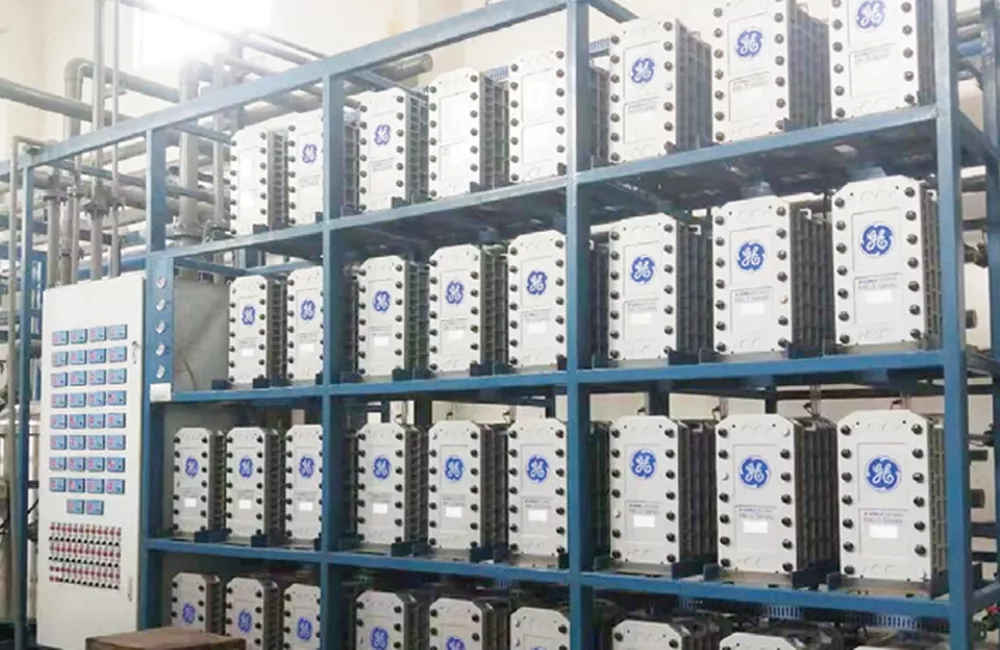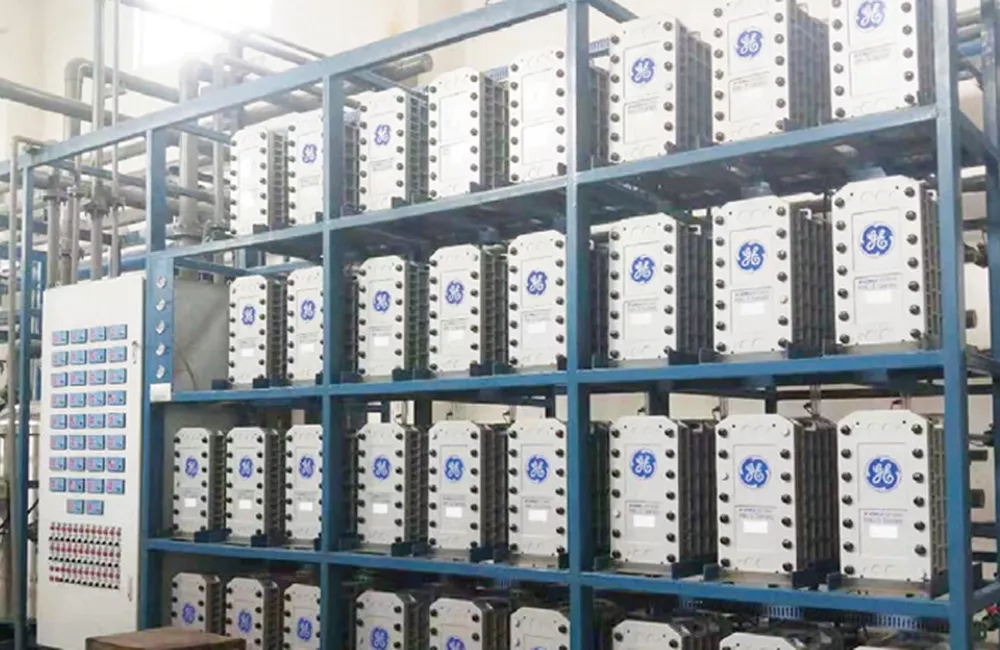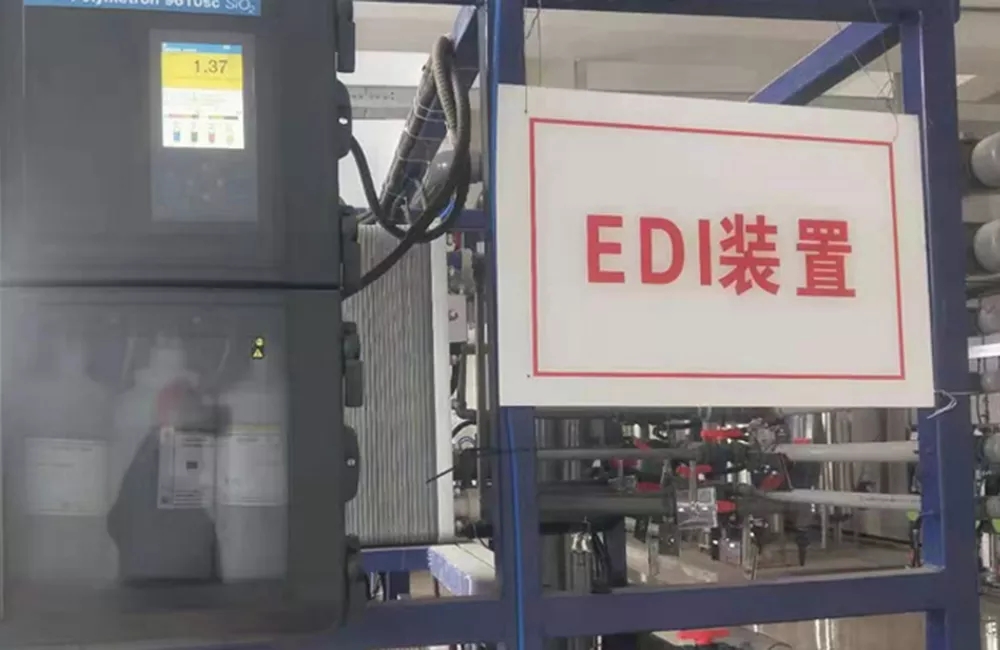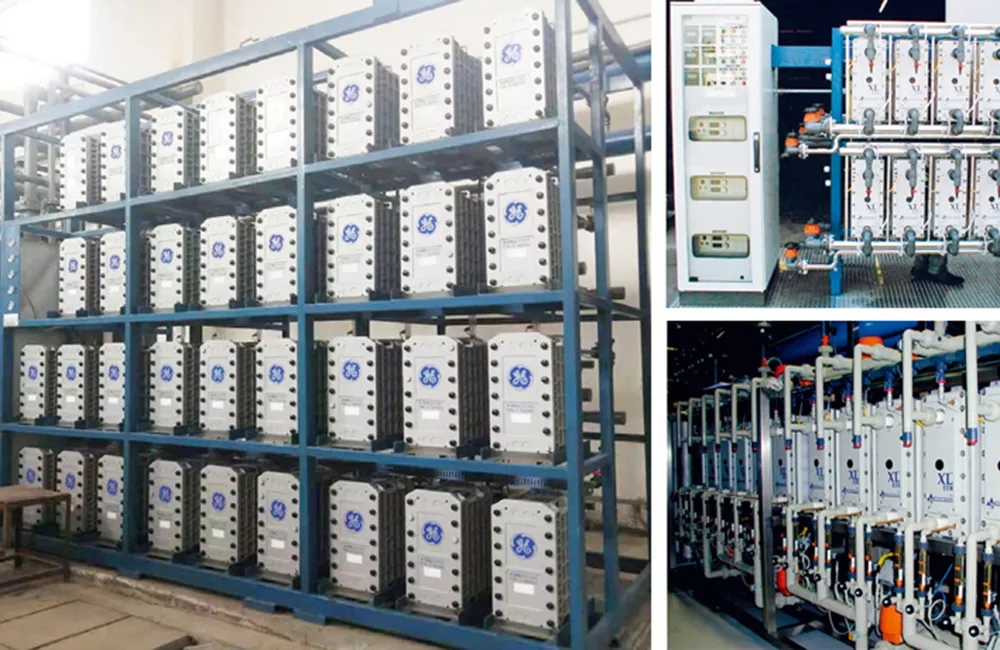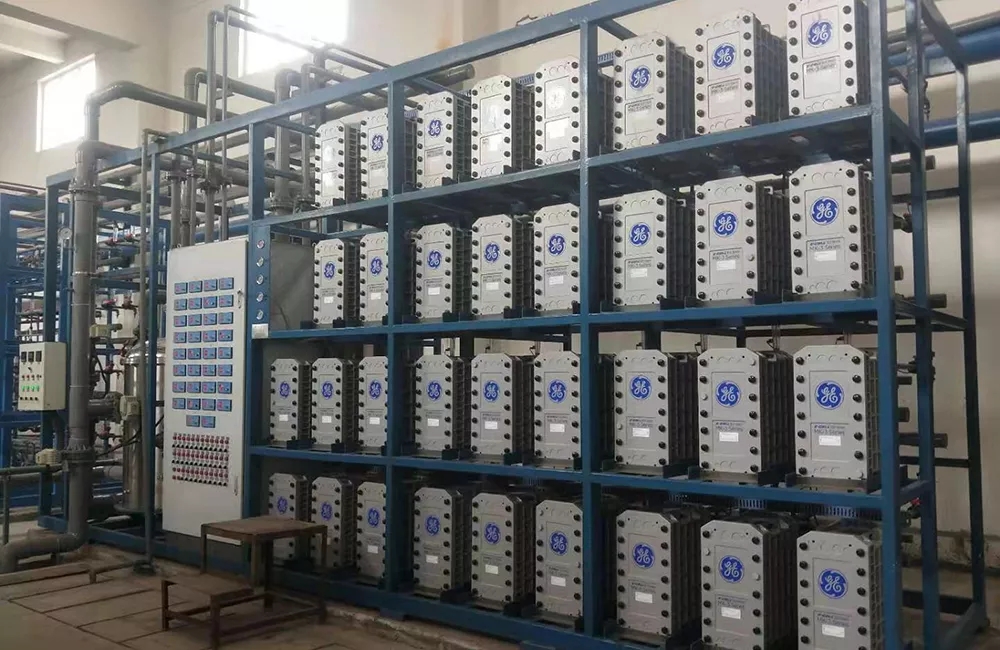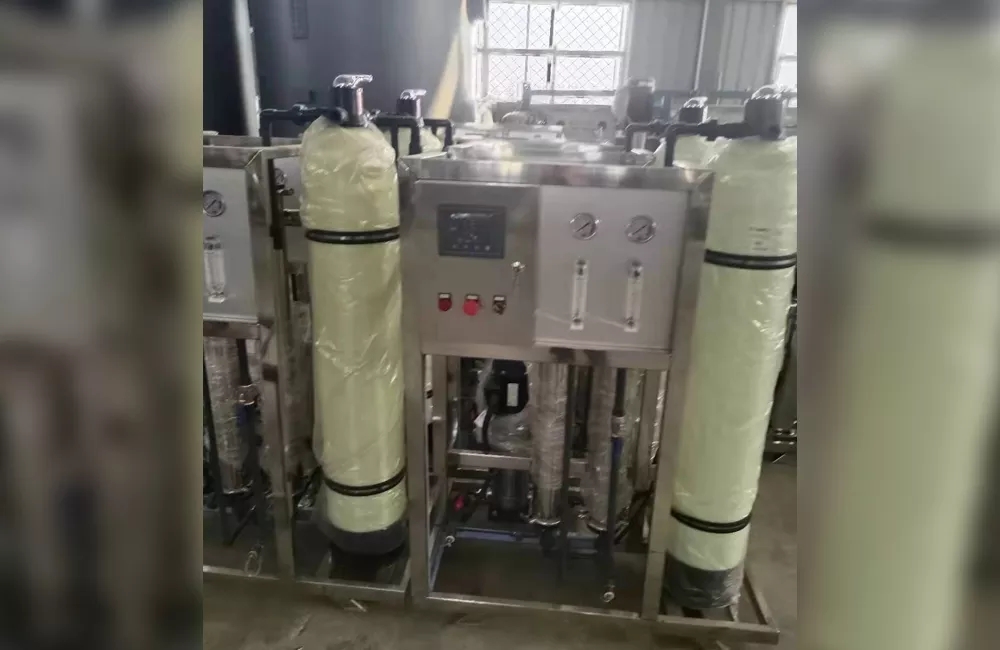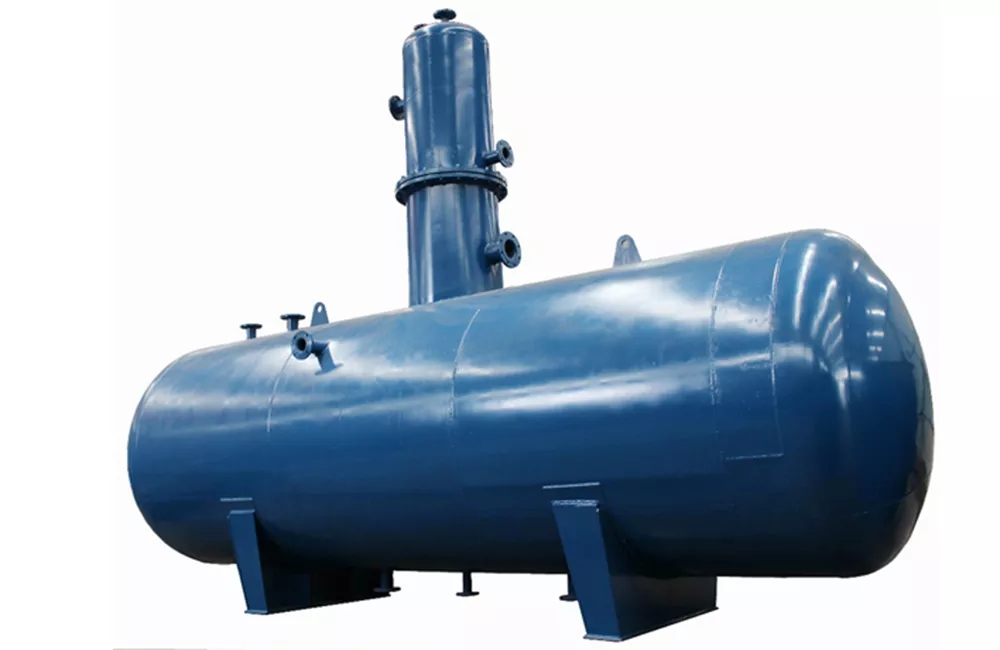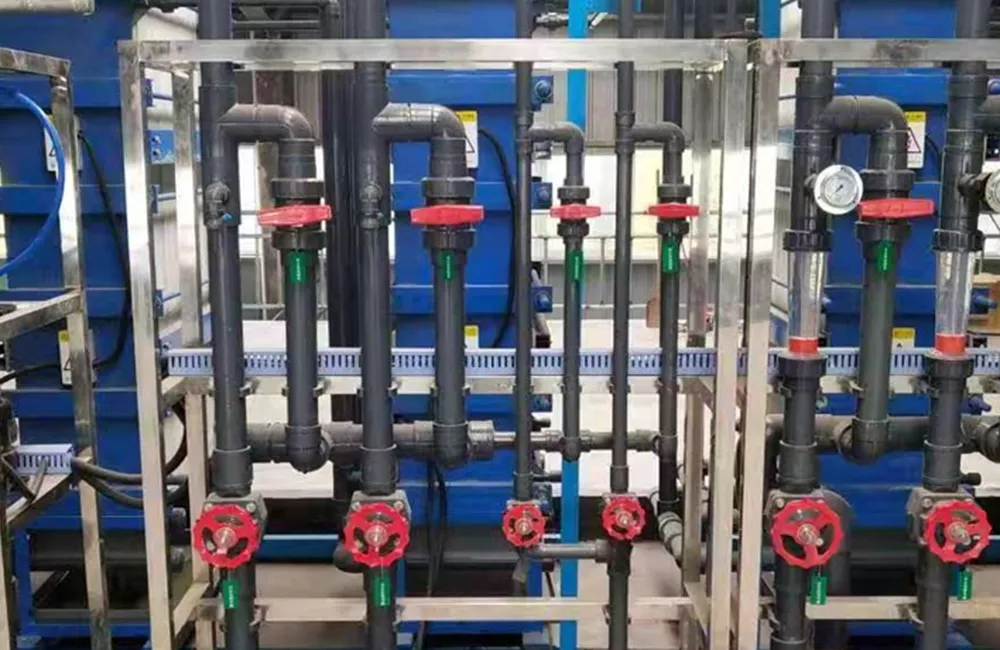EDI
- Mobile: 0086-18660722657
- E-mail: 18660722657@163.com
- download: picture album
The water from groundwater sources contains sodium, calcium, magnesium, chloride, nitrate,bicarbonate, silica and other dissolved salts. These salts consist of anion and cation, which are negatively charged. More than 99% of the ions can be removed by proper reverse osmosis (RO) treatment. City water contains heavy metals, dissolved gases (such as CO2), and other weakly ionized compounds that must be removed during industrial applications (such as boron and silicon).
The conductivity of RO permeation water (EDI inlet water) is generally 4-20 μs /cm, that is, the resistivity is between 50-250K Ω. Cm. Depending on the application area, the resistivity of ultrapure water or deionized water generally varies between 2-18.2MΩ. Cm.
EDI technology combines the advantages of ion exchange and mixed bed ion exchange, which can use ion exchange to do deep treatment, and do not need to be regenerated. The use of ionization of H+ and OH-, to achieve the purpose of regeneration resin.
EDI works by exchanging hydroxyl or hydroxide ions to remove unwanted ions, which are then transported to a wastewater stream. The ion exchange reaction takes place in the purification chamber of the module, where the anion exchange resin releases hydroxide ions (OH-) and obtains anions from the dissolved salts (e.g., chloride, Cl-). Similarly, cation exchange resins give off hydrogen ions (H+) to obtain cations from dissolved salts (e.g., sodium, Na+).
A direct current (DC) electric field is applied through an anode (+) and a cathode (-) placed at one end of the component. The voltage drives these absorbed ions along the surface of the resin sphere and through the membrane into the concentrated water chamber.
Negative anions (e.g., OH-, Cl-) are attracted to the anode (+). These ions pass through the anion-selective film and enter the adjacent concentration chamber, rather than passing through the adjacent cationic-selective film and remaining in the concentration chamber, and are treated properly. In the fresh water chamber, positively charged cations (e.g., H+, Na+) are attracted to the cathode (-). These ions pass through the cationic-selective membrane and into the adjacent concentrated chamber, where they are blocked by the adjacent anion-selective membrane while being properly treated.
In the concentrated water chamber, electricity neutrality is still maintained. Ions coming from both directions neutralize each other. The current flowing from the source is proportional to the number of moving ions. Both streams of water (H+ and OH-) trend ions are transported and added to the desired current.
Water flows through two different types of chambers, and the ions in the purification chamber are depleted and collected into a nearby thick stream, which removes the removed ions from the assembly.
The use of ion-exchange resins in purification chambers and/or concentrated chambers is a key to CanPure's EDI technology and patents. Another important phenomenon that occurs in the purification chamber is that in specific regions with high potential gradients, electrochemical "decomposition" enables the water to produce large amounts of H+ and OH- ions. The H+ and OH- ions produced in these regions can regenerate the resin continuously in the mixed ion exchange resin and form thin films that do not require additional chemical agents.
EDI Component Structure
The fresh water chamber fills the ion exchange resin between the anion exchange membrane and the cation exchange membrane to form a fresh water unit.
The concentrated water chamber is formed by adding resin between the cation and ion exchange membranes of adjacent fresh water units.
The electrode water chamber is formed by adding resin between the electrode plate and the adjacent ion exchange membrane. There are positive and negative polar water chambers in one assembly.
Insulation board and compaction board.
Power and waterway connection.
EDI Advantages
The patented DOWTM EDI module consists of a spiral membrane sealed together with an ion exchange resin in a high-strength pressure vessel.
The performance of DOWTM EDI is stable, the resistivity of water production can reach more than 18+MΩ-cm, and has a strong silicon and boron removal ability. It is a truly economic product that can realize the deep desalination treatment of desalination.
EDI can realize the depth of desalination desalination treatment of truly economic products.
No leakage: Different from the multi-layer mechanical seal adopted by the traditional plate and frame EDI, DOWTM EDI can reliably seal simply through the top cover and the bottom cover, eliminating the common leakage problem of plate and frame EDI.
Low energy consumption: The DOWTM EDI design reduces the distance between the cathode and anode, thus reducing the energy consumption needed to remove ions. It is also equipped with a patented rectifier, which saves up to 64% energy compared to conventional EDI.
Low maintenance requirements: The cleaning frequency of DOWTM EDI is greatly reduced due to the small scaling tendency, and it does not need to tighten the nut as often as traditional plate and frame EDI. Compared with the plate and frame EDI, the investment and operation cost of DOWTM EDI are relatively low.
More economical: Compared with the traditional plate and frame EDI, the DowTM spiral EDI module is an economical alternative to the traditional ion exchange mixed bed due to its relatively low investment and execution cost of the combined system.
Replaceable: DowTM EDI is the only EDI product that can easily replace resin and membrane core. It reduces the replacement cost by 40%, and is more suitable for the condition of poor water quality and easy pollution of resin and film.
The conductivity of RO permeation water (EDI inlet water) is generally 4-20 μs /cm, that is, the resistivity is between 50-250K Ω. Cm. Depending on the application area, the resistivity of ultrapure water or deionized water generally varies between 2-18.2MΩ. Cm.
EDI technology combines the advantages of ion exchange and mixed bed ion exchange, which can use ion exchange to do deep treatment, and do not need to be regenerated. The use of ionization of H+ and OH-, to achieve the purpose of regeneration resin.
EDI works by exchanging hydroxyl or hydroxide ions to remove unwanted ions, which are then transported to a wastewater stream. The ion exchange reaction takes place in the purification chamber of the module, where the anion exchange resin releases hydroxide ions (OH-) and obtains anions from the dissolved salts (e.g., chloride, Cl-). Similarly, cation exchange resins give off hydrogen ions (H+) to obtain cations from dissolved salts (e.g., sodium, Na+).
A direct current (DC) electric field is applied through an anode (+) and a cathode (-) placed at one end of the component. The voltage drives these absorbed ions along the surface of the resin sphere and through the membrane into the concentrated water chamber.
Negative anions (e.g., OH-, Cl-) are attracted to the anode (+). These ions pass through the anion-selective film and enter the adjacent concentration chamber, rather than passing through the adjacent cationic-selective film and remaining in the concentration chamber, and are treated properly. In the fresh water chamber, positively charged cations (e.g., H+, Na+) are attracted to the cathode (-). These ions pass through the cationic-selective membrane and into the adjacent concentrated chamber, where they are blocked by the adjacent anion-selective membrane while being properly treated.
In the concentrated water chamber, electricity neutrality is still maintained. Ions coming from both directions neutralize each other. The current flowing from the source is proportional to the number of moving ions. Both streams of water (H+ and OH-) trend ions are transported and added to the desired current.
Water flows through two different types of chambers, and the ions in the purification chamber are depleted and collected into a nearby thick stream, which removes the removed ions from the assembly.
The use of ion-exchange resins in purification chambers and/or concentrated chambers is a key to CanPure's EDI technology and patents. Another important phenomenon that occurs in the purification chamber is that in specific regions with high potential gradients, electrochemical "decomposition" enables the water to produce large amounts of H+ and OH- ions. The H+ and OH- ions produced in these regions can regenerate the resin continuously in the mixed ion exchange resin and form thin films that do not require additional chemical agents.
EDI Component Structure
The fresh water chamber fills the ion exchange resin between the anion exchange membrane and the cation exchange membrane to form a fresh water unit.
The concentrated water chamber is formed by adding resin between the cation and ion exchange membranes of adjacent fresh water units.
The electrode water chamber is formed by adding resin between the electrode plate and the adjacent ion exchange membrane. There are positive and negative polar water chambers in one assembly.
Insulation board and compaction board.
Power and waterway connection.
EDI Advantages
The patented DOWTM EDI module consists of a spiral membrane sealed together with an ion exchange resin in a high-strength pressure vessel.
The performance of DOWTM EDI is stable, the resistivity of water production can reach more than 18+MΩ-cm, and has a strong silicon and boron removal ability. It is a truly economic product that can realize the deep desalination treatment of desalination.
EDI can realize the depth of desalination desalination treatment of truly economic products.
No leakage: Different from the multi-layer mechanical seal adopted by the traditional plate and frame EDI, DOWTM EDI can reliably seal simply through the top cover and the bottom cover, eliminating the common leakage problem of plate and frame EDI.
Low energy consumption: The DOWTM EDI design reduces the distance between the cathode and anode, thus reducing the energy consumption needed to remove ions. It is also equipped with a patented rectifier, which saves up to 64% energy compared to conventional EDI.
Low maintenance requirements: The cleaning frequency of DOWTM EDI is greatly reduced due to the small scaling tendency, and it does not need to tighten the nut as often as traditional plate and frame EDI. Compared with the plate and frame EDI, the investment and operation cost of DOWTM EDI are relatively low.
More economical: Compared with the traditional plate and frame EDI, the DowTM spiral EDI module is an economical alternative to the traditional ion exchange mixed bed due to its relatively low investment and execution cost of the combined system.
Replaceable: DowTM EDI is the only EDI product that can easily replace resin and membrane core. It reduces the replacement cost by 40%, and is more suitable for the condition of poor water quality and easy pollution of resin and film.
Water supply: water produced by reverse osmosis.
TEA (total exchangeable anion, as CaCO3) : <35ppm.
TEA includes all anions and substances removed by EDI in the form of anions. Since the CO2, SiO2 and H3BO3 contained in water were cleared by EDI in the form of HCO3- / CO32-, HSIO3 - / SiO32- and B(OH)4-, the charges of TEA were -1.7, -1.5 and -1.0, respectively, when calculated according to experience. HCO3- is also partially removed in the form of CO32-, and the charge is also calculated as -1.7 in the calculation of TEA.
TEA=50[CCl-/35.5+2CSO42-/96+1.7CCO2/44+1.7CHCO3-/61+1.5CSiO2/60+ …]
The concentration of all substances is measured in mg/L.
pH:6.0~9.0
When the total hardness was lower than 0.1 PPM, the optimum pH value of EDI was 8.0 ~ 9.0.
Note: pH value is the reference index of water supply, and it is one of the indexes that indirectly reflect the CO2 content of water supply.
Temperature : 5-35°C
inlet water <0.4MPa(60psi)
Hardness (CaCO3) : <10.0 PPM.
Note: EDI process needs to limit the inlet hardness to avoid scaling. When the influent hardness is below 10.0 PPM, the water utilization rate of GE EDI system in the United States is 90%. Excessive pursuit of higher water efficiency makes little sense, since both 100% concentrated water and extreme water in the EDI system can be reused back before reverse osmosis.
Organic matter (TOC) : <0.5 PPM.
Oxidant: Cl2< 0.05ppm, O3< 0.02ppm.
Variable metal: Fe< 0.01ppm, Mn< 0.01ppm.
H2S: <0.01 PPM.
Silica: <0.5 PPM.
SDI 15min: <1.0.
Colour: <5 APHA.
Total carbon dioxide:
Conductivity: <20 μs /cm.
Carbon dioxide content and pH value will significantly affect the product water resistivity. If the CO2 content is greater than 10 PPM, the US GE EDI system cannot prepare high purity product water. The CO2 can be reduced by adjusting the pH value of the reverse osmosis inlet water or by using a degassing device. In addition, excessive carbon dioxide content will also increase the content of carbonate and bicarbonate on the surface of the anion exchange membrane, and increase the possibility of scaling on the membrane surface.
EDI module operation results depend on a variety of operating conditions, including system design parameters, feed water quality, feed water pressure, etc.Typical operating conditions are listed in the table below.
Caution: When the current passes through the EDI module, heat will be generated. During EDI operation, the heat must be taken out by water flow. Therefore, when the fresh water and concentrated water flow of EDI module is not smooth or stops, the power supply must be stopped, otherwise the EDI module will be completely burned out.
TEA (total exchangeable anion, as CaCO3) : <35ppm.
TEA includes all anions and substances removed by EDI in the form of anions. Since the CO2, SiO2 and H3BO3 contained in water were cleared by EDI in the form of HCO3- / CO32-, HSIO3 - / SiO32- and B(OH)4-, the charges of TEA were -1.7, -1.5 and -1.0, respectively, when calculated according to experience. HCO3- is also partially removed in the form of CO32-, and the charge is also calculated as -1.7 in the calculation of TEA.
TEA=50[CCl-/35.5+2CSO42-/96+1.7CCO2/44+1.7CHCO3-/61+1.5CSiO2/60+ …]
The concentration of all substances is measured in mg/L.
pH:6.0~9.0
When the total hardness was lower than 0.1 PPM, the optimum pH value of EDI was 8.0 ~ 9.0.
Note: pH value is the reference index of water supply, and it is one of the indexes that indirectly reflect the CO2 content of water supply.
Temperature : 5-35°C
inlet water <0.4MPa(60psi)
Hardness (CaCO3) : <10.0 PPM.
Note: EDI process needs to limit the inlet hardness to avoid scaling. When the influent hardness is below 10.0 PPM, the water utilization rate of GE EDI system in the United States is 90%. Excessive pursuit of higher water efficiency makes little sense, since both 100% concentrated water and extreme water in the EDI system can be reused back before reverse osmosis.
Organic matter (TOC) : <0.5 PPM.
Oxidant: Cl2< 0.05ppm, O3< 0.02ppm.
Variable metal: Fe< 0.01ppm, Mn< 0.01ppm.
H2S: <0.01 PPM.
Silica: <0.5 PPM.
SDI 15min: <1.0.
Colour: <5 APHA.
Total carbon dioxide:
Conductivity: <20 μs /cm.
Carbon dioxide content and pH value will significantly affect the product water resistivity. If the CO2 content is greater than 10 PPM, the US GE EDI system cannot prepare high purity product water. The CO2 can be reduced by adjusting the pH value of the reverse osmosis inlet water or by using a degassing device. In addition, excessive carbon dioxide content will also increase the content of carbonate and bicarbonate on the surface of the anion exchange membrane, and increase the possibility of scaling on the membrane surface.
EDI module operation results depend on a variety of operating conditions, including system design parameters, feed water quality, feed water pressure, etc.Typical operating conditions are listed in the table below.
Caution: When the current passes through the EDI module, heat will be generated. During EDI operation, the heat must be taken out by water flow. Therefore, when the fresh water and concentrated water flow of EDI module is not smooth or stops, the power supply must be stopped, otherwise the EDI module will be completely burned out.

